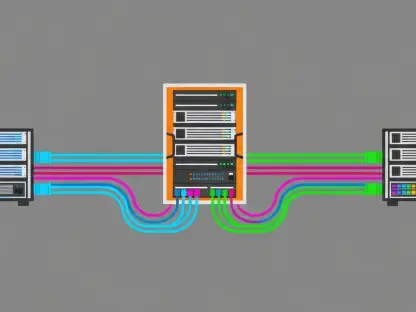In an industry where trust and security are paramount, the recent cyberattack on SitusAMC, a pivotal vendor in the financial-services sector, has exposed alarming weaknesses in the market’s digital infrastructure. On November 12 of this year, this major player, which supports over 1,500 clients in managing real estate loans and mortgages, suffered a breach that compromised sensitive data, including banks’ accounting records, legal agreements, and customer information. This incident, reported just weeks later on November 24, has rattled financial institutions and raised urgent questions about the sector’s preparedness for supply-chain attacks. This market analysis delves into the implications of the breach, examines current trends in cybersecurity vulnerabilities, and offers projections on how the industry might evolve to address these risks. The focus is on understanding systemic gaps and identifying strategic pathways to strengthen defenses in a rapidly digitizing financial landscape.
Market Trends and DatThe Rising Threat of Supply-Chain Attacks
Growing Exposure Through Third-Party Vendors
The financial sector, despite its heavy investment in cybersecurity, remains a prime target for cybercriminals due to the immense value of its data and its critical role in global economies. SitusAMC, as a key vendor facilitating operations for numerous banks, exemplifies the industry’s reliance on third-party providers, a trend that has accelerated with digital transformation in recent years. Data from the Cybersecurity and Infrastructure Security Agency (CISA) indicates that supply-chain attacks have surged by over 40% since 2020, with finance being among the most targeted sectors. This growing exposure stems from disparities in security measures, where vendors often operate with less robust defenses compared to their banking partners, creating exploitable entry points for attackers.
Economic and Operational Impacts of Breaches
Beyond immediate data theft, breaches like the one at SitusAMC carry significant economic repercussions for the market. The compromised information—ranging from financial records to customer details—can erode consumer confidence and trigger costly legal and regulatory consequences for affected institutions. Operationally, while SitusAMC has confirmed that the breach is contained and services remain unaffected, the incident highlights potential disruptions in trust between banks and their vendors. Market analysts project that the financial cost of such cyberattacks could escalate if stolen data is leveraged for further fraud or sold on dark web marketplaces, amplifying the urgency for preemptive measures across the sector.
Regulatory and Technological Responses on the Horizon
Looking at current market patterns, there is a noticeable push toward stricter regulatory oversight and technological innovation to combat these threats. Governments and industry bodies are increasingly focusing on vendor accountability, with discussions around mandating comprehensive security audits for third-party providers gaining traction. Simultaneously, the adoption of advanced tools like artificial intelligence for threat detection and zero-trust architectures is on the rise, as financial institutions seek to limit internal vulnerabilities. Projections suggest that by 2027, supply-chain security could become a cornerstone of financial regulations, potentially reshaping operational models and vendor partnerships in the market.
Future Projections: Navigating an Evolving Threat Landscape
Anticipated Shifts in Cybersecurity Investments
As the financial sector grapples with incidents like the SitusAMC breach, market forecasts point to a significant uptick in cybersecurity investments over the next few years. Analysts expect institutions to allocate greater resources toward real-time monitoring systems and vendor risk management frameworks, driven by the need to detect and mitigate threats swiftly. Smaller vendors, often the weakest links, may face pressure to enhance their security protocols, potentially leading to consolidation in the market as only those with robust defenses survive. This shift could redefine competitive dynamics, prioritizing security as a key differentiator among service providers.
Collaborative Models and Industry-Wide Standards
Another critical projection for the financial market involves the rise of collaborative defense models. The interconnected nature of supply chains necessitates shared responsibility, with experts anticipating the development of industry-wide standards for cybersecurity by mid-decade. Public-private partnerships are likely to play a pivotal role, fostering information sharing and coordinated responses to cyber threats. The involvement of agencies like the FBI in the SitusAMC investigation underscores the growing recognition of critical infrastructure protection as a collective endeavor, a trend expected to strengthen as threats become more sophisticated.
Emerging Innovations and Market Opportunities
On the innovation front, the market is poised to witness rapid advancements in blockchain-based security solutions and automated compliance tools, which could offer scalable ways to secure supply chains. While adoption remains limited due to cost barriers, declining implementation expenses and increasing regulatory incentives may drive wider uptake by 2027. These technologies present opportunities for fintech companies to carve out niches in cybersecurity, potentially disrupting traditional vendor models. The financial sector stands at a crossroads, where embracing such innovations could transform vulnerabilities into competitive advantages for early adopters.
Reflecting on the Market Analysis: Strategic Pathways Forward
Looking back on the detailed examination of the SitusAMC cyberattack, it becomes evident that supply-chain vulnerabilities pose a persistent threat to the financial-services market, challenging even the most fortified institutions. The incident, reported on November 24 of this year, serves as a critical case study in how third-party dependencies can undermine sector-wide security. Key implications point to an urgent need for systemic reform, from economic impacts to regulatory gaps. Moving forward, stakeholders are encouraged to prioritize rigorous vendor assessments and advocate for shared liability frameworks to distribute risk more evenly. Financial institutions need to invest in continuous monitoring and foster partnerships with vendors committed to robust security practices. Additionally, exploring emerging technologies like blockchain offers a proactive way to stay ahead of evolving threats, ensuring that the lessons from this breach translate into a more resilient market landscape.









